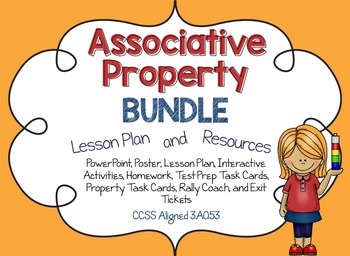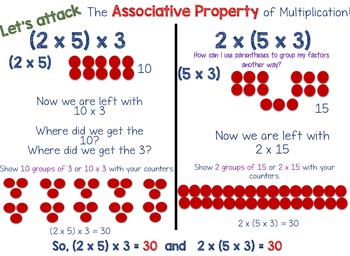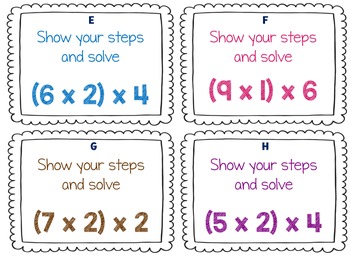Associative Property of Multiplication Lesson Plan and Resources: CCSS 3.OA.5
Elementary Brown-ies
542 Followers
Grade Levels
3rd - 4th, Homeschool
Subjects
Resource Type
Standards
CCSS3.OA.A.1
CCSS3.OA.A.2
CCSS3.OA.A.3
CCSS3.OA.A.4
CCSS3.OA.B.5
Formats Included
- Zip
Pages
15 pages
Elementary Brown-ies
542 Followers
What educators are saying
Awesome resource for my classroom! Thank you so much for sharing. I’ve loved having it to work together in small groups.
I really enjoyed using this resource. It was exactly what I was looking for when introducing this skill.
Description
This lesson pack focuses on the Associative Property of Multiplication.
Pack Includes:
Associative Property Poster
Interactive PowerPoint on the Associative Property
Notes for the teacher
Associative Property with Pasta Parentheses activity instructions
Associative Property with Pasta Parentheses student activity sheet
16 Associative Property Test Prep Task Cards
12 ASsociative Property Algorithm Practice Task Cards
Associative Property Task Cards Student Recording Sheet
Rally Coach (Partner Activity)
Exit Ticket
Common Core Aligned 3.OA.5
Pack Includes:
Associative Property Poster
Interactive PowerPoint on the Associative Property
Notes for the teacher
Associative Property with Pasta Parentheses activity instructions
Associative Property with Pasta Parentheses student activity sheet
16 Associative Property Test Prep Task Cards
12 ASsociative Property Algorithm Practice Task Cards
Associative Property Task Cards Student Recording Sheet
Rally Coach (Partner Activity)
Exit Ticket
Common Core Aligned 3.OA.5
Total Pages
15 pages
Answer Key
N/A
Teaching Duration
2 days
Report this resource to TPT
Reported resources will be reviewed by our team. Report this resource to let us know if this resource violates TPT’s content guidelines.
Standards
to see state-specific standards (only available in the US).
CCSS3.OA.A.1
Interpret products of whole numbers, e.g., interpret 5 × 7 as the total number of objects in 5 groups of 7 objects each. For example, describe a context in which a total number of objects can be expressed as 5 × 7.
CCSS3.OA.A.2
Interpret whole-number quotients of whole numbers, e.g., interpret 56 ÷ 8 as the number of objects in each share when 56 objects are partitioned equally into 8 shares, or as a number of shares when 56 objects are partitioned into equal shares of 8 objects each. For example, describe a context in which a number of shares or a number of groups can be expressed as 56 ÷ 8.
CCSS3.OA.A.3
Use multiplication and division within 100 to solve word problems in situations involving equal groups, arrays, and measurement quantities, e.g., by using drawings and equations with a symbol for the unknown number to represent the problem.
CCSS3.OA.A.4
Determine the unknown whole number in a multiplication or division equation relating three whole numbers. For example, determine the unknown number that makes the equation true in each of the equations 8 × ? = 48, 5 = __ ÷ 3, 6 × 6 = ?.
CCSS3.OA.B.5
Apply properties of operations as strategies to multiply and divide. Examples: If 6 × 4 = 24 is known, then 4 × 6 = 24 is also known. (Commutative property of multiplication.) 3 × 5 × 2 can be found by 3 × 5 = 15, then 15 × 2 = 30, or by 5 × 2 = 10, then 3 × 10 = 30. (Associative property of multiplication.) Knowing that 8 × 5 = 40 and 8 × 2 = 16, one can find 8 × 7 as 8 × (5 + 2) = (8 × 5) + (8 × 2) = 40 + 16 = 56. (Distributive property.)





